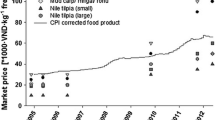Abstract
The experiments on the intensive–extensive system were carried out between 2008 and 2010 in three ponds (area 310 m2, depth 1 m) serving as extensive units, where cages were placed as an intensive units (volume 10 m3) one in each pond. In the intensive units, African catfish (Clarias gariepinus) was cultured and fed with pellet whilst common carp (Cyprinus carpio) was stocked in each extensive unit and raised without any artificial feeding. Three different setups of extensive ponds were tested: the additional artificial plastic substrate for periphyton development equalled to 0, 100 and 200 % of the pond surface area (PP0 %, PP100 % and PP200 %) at feed loading level of 1.2, 1.9 and 2.8 gN m−2 day−1 in 2008, 2009 and 2010, respectively. The additional net fish yields in the extensive unit were 2.8–6.5 t ha−1 in PP0 %, 5.1–8.1 t ha−1 in PP100 % and 2.1–4.3 t ha−1 in PP200 %. The nitrogen recovery in the additional fish yields of extensive ponds, expressed as the percentage of feed load, was 5.6–6.1, 6.8–10 and 2.1–6.1 % in the treatments PP0 %, PP100 % and PP200 %, respectively. The combined fish production resulted in higher protein utilisation by 22–26 %; even this ratio can be increased by 33–45 % with periphyton application.

Similar content being viewed by others
References
Adamek Z, Gál D, Pilarczyk M (2009) Carp farming as a traditional type of pond aquaculture in Central Europe: prospects and weakneses in the Czech Republic, Hungary and Poland. Eur Aquac Soc Spec Pub 37:80–81
Asaduzzaman M, Wahab MA, Verdegem MCJ, Huque S, Salam MA, Azim ME (2008) C/N ratio control and substrate addition for periphyton development jointly enhance freshwater prawn Macrobrachium rosenbergii production in ponds. Aquaculture 280:117–123
Avnimelech Y, Weber B, Hepher B, Milstein A, Zorn M (1986) Studies in circulated fish ponds: organic matter recycling and nitrogen transformation. Aquac Fish Manag 17:231–242
Azim ME (2001) The potential of periphyton-based aquaculture production systems. Dissertation, Wageningen University, The Netherlands
Azim ME, Wahab MA, van Dam AA, Beveridge MCM, Huisman EA, Verdegem MCJ (2001) The potential of periphyton-based culture of two Indian major carps, rohu Labeo rohita (Hamilton) and gonia Labeo gonius (Linnaeus). Aquac Res 32:209–216
Bíró P (1995) Management of pond ecosystems and trophic webs. Aquaculture 129:373–386
Diab S, Kochba M, Mires D, Avnimelech Y (1992) Combined intensive-extensive (CIE) pond system A: inorganic nitrogen transformations. Aquaculture 101:33–39
Füllner G, Gottschalk T, Pfeifer M (2007) Experiments for the production of hybrid striped bass in in-pond circulation system. Aquacult Int 15:241–248
Gál D, Szabó P, Pekár F, Váradi L (2003) Experiments on the nutrient removal and retention of a pond recirculation system. Hydrobiologia 506(1–3):767–772
Gál D, Kerepeczki É, Szabó P, Pekár F (2008) A survey on the environmental impact of pond aquaculture in Hungary. Eur Aquac Soc Spec Pub 37:230–231
Kestemont P (1995) Different systems of carp production and their impacts on the environment. Aquaculture 129:347–372
Knösche R, Schreckenbach K, Pfeifer M, Weissenbach H (2000) Balances of phosphorus and nitrogen in carp ponds. Fish Manag Ecol 7:15–22
Kosáros T, Gál D, Pekár F, Lakatos G (2010) Effect of different treatments on the periphyton quantity and quality in experimental fishponds. World Acad Sci Eng Technol 40:363–366
Kosáros T, Pekár F, Gál D, Lakatos G (2011) Periphyton utilisation in aquatic ecosystems: improvement of fish production and water treatment. Studia Universitatis Vasile Goldis Seria Stiintele Vietii (in press)
McConnel WJ (1962) Productivity relations in carbon microcosm. Limnol Oceoanogr 7:335–343
Milstein A, Peretz Y, Harpaz S (2008) Periphyton as food in organic tilapia culture: comparison of periphyton growth on different substrates. Isr J Aquac-Bamidgeh 60(4):243–252
Oláh J, Szabó P, Esteky AA, Nezami SA (1994) Nitrogen processing and retention on a Hungarian carp farms. J Appl Ichthyol 10:335–340
Scherz H, Senser F (1994) Food composition and nutrition tables. Medpharm Scientific Publishers, Boca Raton
Schneider O, Sereti V, Eding EH, Vereth JAJ (2005) Analysis of nutrient flows in integrated intensive aquaculture systems. Aquac Eng 32:379–401
Wahab MA, Azim ME, Ali MH, Beveridge MCM, Khan S (1999) The potential of periphyton-based culture of the native major carp kalbaush, Labeo calbasu (Hamilton). Aquac Res 30:409–419
Acknowledgments
Financial support for the research was provided by the SustainAqua EC-project and Ministry of Rural Development. This study was implemented under the Hungary-Romania Cross-Border Co-operation Programme and is part-financed by the European Union through the European Regional Development Fund, and the Republic of Hungary and Romania.
Author information
Authors and Affiliations
Corresponding author
Rights and permissions
About this article
Cite this article
Gál, D., Pekár, F., Kosáros, T. et al. Potential of nutrient reutilisation in combined intensive–extensive pond systems. Aquacult Int 21, 927–937 (2013). https://doi.org/10.1007/s10499-012-9561-1
Received:
Accepted:
Published:
Issue Date:
DOI: https://doi.org/10.1007/s10499-012-9561-1




